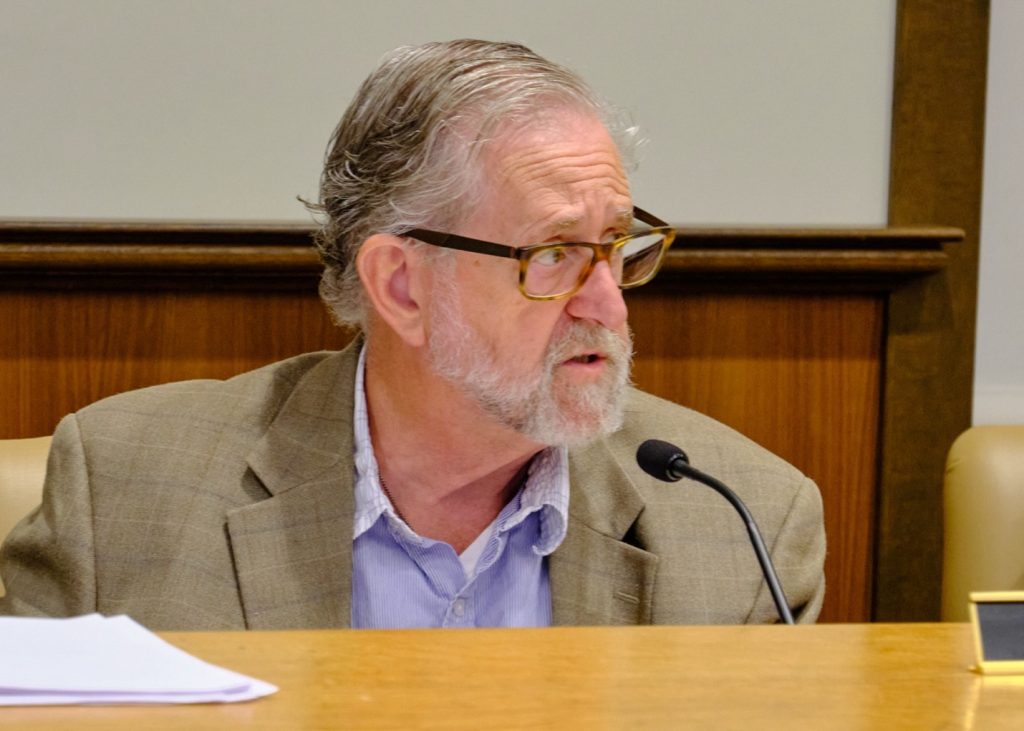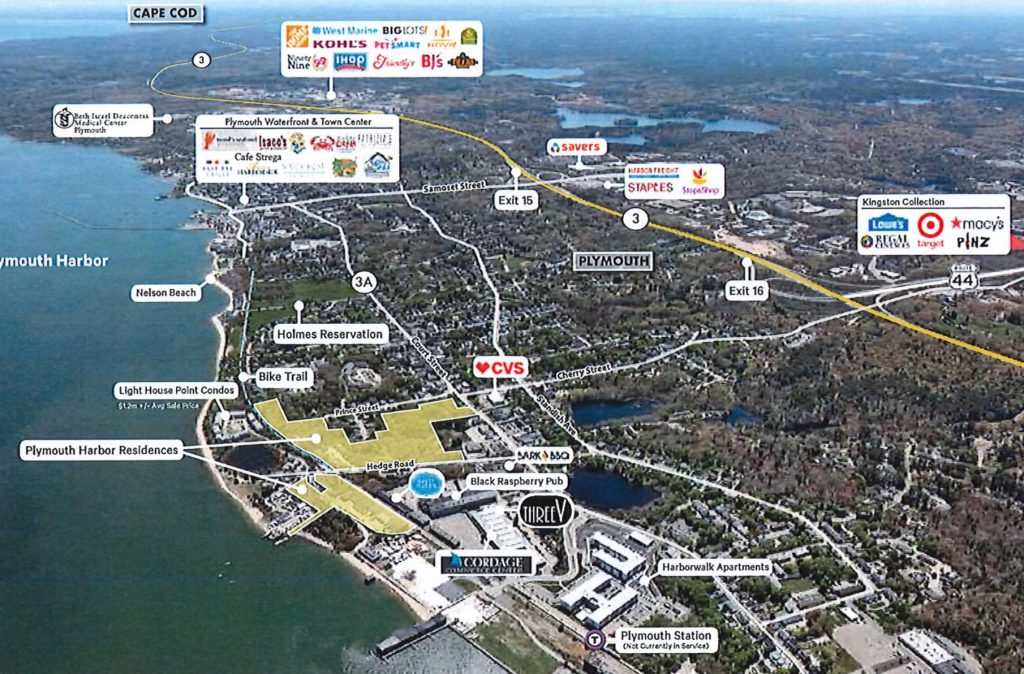Be careful what you wish for.
Neighbors have battled the proposed Claremont apartment project at Colony Place for nearly two years. They filed appeal after appeal, alleging the town violated an array of laws when it issued special permits for the 198-unit complex.
Now, they have finally gotten their wish — the developer is withdrawing its plans for the site, town officials said.
But instead of walking away from the project, designed for tenants aged 55 or older, Claremont says it will build affordable housing on the land under the state’s 40b provisions. That means the complex will likely be denser and taller, with fewer restrictions, than the building that was originally proposed. (The original plans included the possibility of a second building, but Claremont did not finalize or submit plans for it, according to Town Manager Derek Brindisi.)
Under Massachusetts law, communities whose housing supply is less than 10 percent affordable cannot reject 40b projects. (Plymouth is now at 4.88 percent, according to the state.) The builders of these projects are required to make at least 25 percent of their units affordable, but in return they can bypass local zoning and other laws.
“This is a real opportunity for educating people in our community about the realities of living in a 40b state,” said select board member Harry Helm. “There are potential consequences and we’re seeing them here.”

“I’m not saying people don’t have a right to file lawsuits ad infinitum, but developers also have a right to throw up their hands and say, ‘I’ve had enough.’”
Helm said the new project will be 75 percent larger than what Claremont originally planned.
“They can do it,” he said. “With greater traffic, greater density. And I’m sure the (neighbors) are not going to be happy.”
Some of those neighbors — residents of nearby Sawyer’s Reach, another 55-plus complex — are represented by public interest environmental lawyer Meg Sheehan, who has filed multiple court challenges to the original project on their behalf.
They appealed the final Zoning Board of Appeal’s March 2023 decision to issue a special permit incorporating several zoning variances, and brought suits against the Planning Board, the Select Board and Claremont itself.
Sheehan also appealed the town conservation commission’s decision not to require a wetlands permit, which she says it required to install a drainage system. That appeal is also pending.
In court papers, the neighbors claimed the project was out of scale with the area — too tall and too dense — and could cause flooding, erosion, noise, and glare.
They also alleged that the town made a secret deal with the developer in a November 2022 executive session — the state attorney general agreed the town violated the open meeting law — to waive $1.5 million in fees from the developer.
Town officials, who did not contest the AG’s ruling, say the agreement benefited the town because Claremont offered to build a booster water pump in the area at a cost of roughly $3 million— something the town would otherwise have had to pay for.
Sheehan declined comment on Claremont’s change of direction, saying she had “no evidence” that the company has abandoned its original plan.
And, she added, there is still a motion pending in court. That motion, filed by the town and Claremont, asks a judge to order the neighbors to post a $50,000 bond to cover the defendants’ mounting legal fees. A hearing is scheduled for March 21.
Pam Magnarelli, a named plaintiff in the cases filed in Plymouth Superior Court, also declined comment.
Bill Lovett, executive director of real estate development for the Bridgewater-based Claremont Companies, said he couldn’t discuss the company’s plans because of the pending litigation.
“We consider (Plymouth) a strong market,” Lovett said.
Some officials found the outcome of this battle between developer and neighbors sadly ironic.
The building will likely be taller, with more tenants and fewer protections than the developer and town had agreed on, officials said. The company has told the town it is looking to build about 350 apartments.
“They’re adding another 152 units to something that people already complained was too dense,” said Planning Board member Steve Bolotin, who has recused himself from voting on the project because the architect is a law client of his.
“We now lose control,” he said. “There’s no agreement they do anything with the pump. It’s solely up to them. We have no leverage whatsoever. There are no advantages to the town.”
Sawyer’s Reach itself is “a massive development” that received some of the same waivers it has been complaining about,” said Helm.
“This story is full of unfortunate ironies,” including, he said, the fact that Sheehan’s family is in the process of turning land into development opportunities for real estate companies.
The family business — Eight Mates LLC — is in the process of selling land on Hedge Road to Pulte Homes for $11 million, according to town officials. They said Pulte is proposing a 40b project with 150 units.
Town planner Lee Hartmann called the land “one of the last remaining undeveloped coastal wetland resource areas we have in the north of town.”
Another 40-acre parcel owned by the family in Chiltonville is also on the market. A sales brochure says the property, which includes 10.8 acres of wetlands and 1,384 feet of frontage on Eel River, also could accommodate a 40b project.

“If she cared about conservation, she would preserve her family land,” Brindisi said of Sheehan.
Sheehan wouldn’t say whether she’s involved in the family business, asserting in a text that “haters will hate and infer what they want no matter what I say.”
She also said she didn’t want to feed “the defamation campaign against me,” by commenting on Claremont’s plans, adding that “anything I say will be twisted around and used for another lie and Facebook meme.”
The Sawyer’s Reach residents were not the only ones who objected to the Claremont project.
The West Plymouth Steering Committee, which reviews development proposals, opposed the plan, saying it had too many variances and too few specifics.
Birgitta Kuehn, a planning board member and liaison to the steering committee, said people became suspicious of the company’s motives after the Select Board and Zoning Board of Appeals met in closed session November 15, 2022, to discuss concessions — something, she said, had never happened before.
“Just a few years ago the area was all trees,” she said of the Sawyer’s Reach area. “Now it’s one of the most densely populated areas in Plymouth. People felt fooled — they were afraid that Claremont wanted to build the densest apartment complex they could squeeze into two small lots.”
Andrea Estes can be reached at andrea@plymouthindependent.org.

